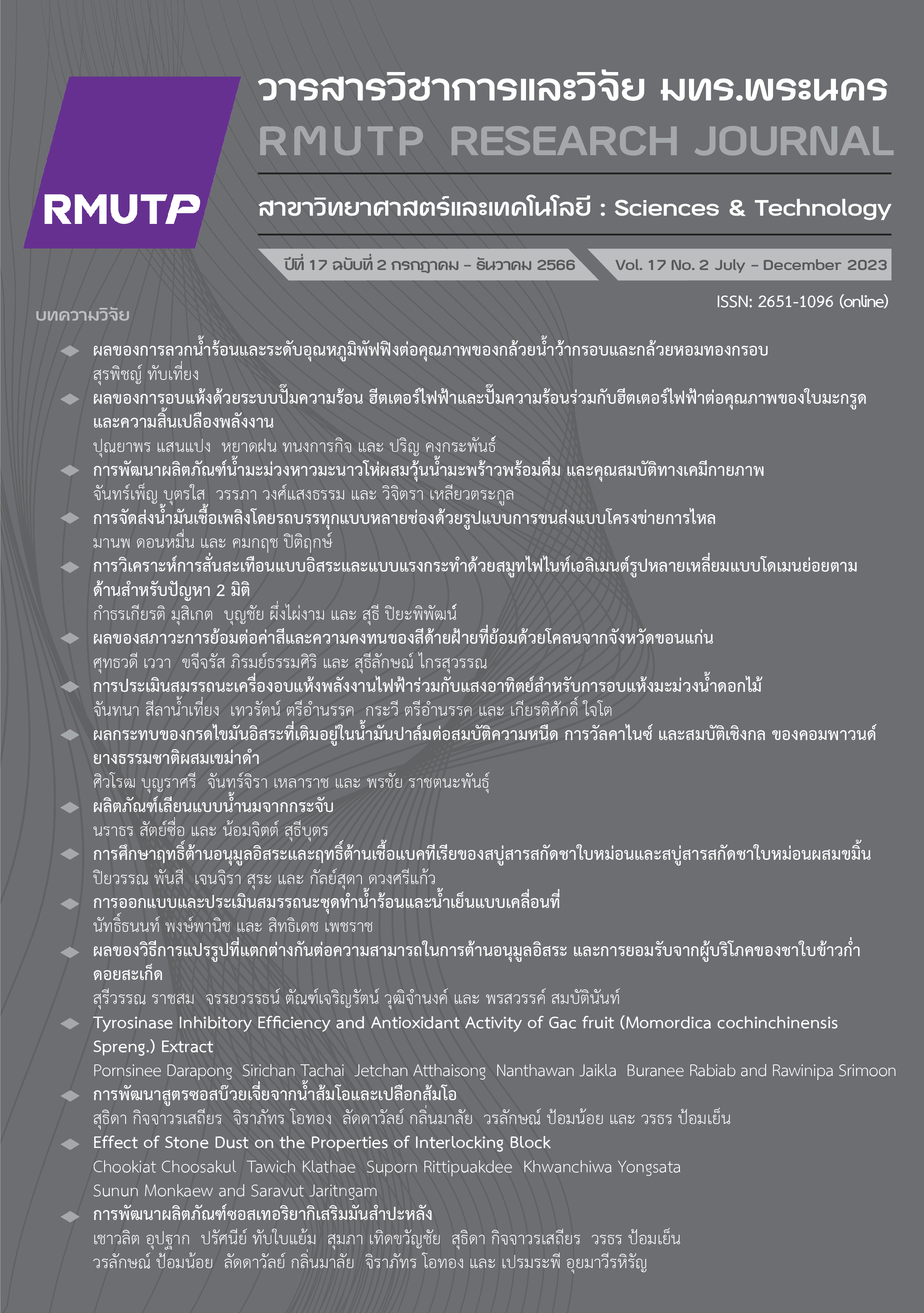Product Development of Teriyaki Sauce Fortified with Cassava
Main Article Content
Abstract
The objective of this research was to study the production process of teriyaki sauce fortified with cassava, Rayong 90 variety, to study the physicochemical properties. Study consumer testing and transfer of technology in the development of teri sauce products Yaki fortified with cassava Results of a study of the production process of teriyaki sauce fortified with cassava. At the 0, 20, 30, and 40 percent levels of all ingredients, it was found that the testers accepted the 20 percent level, which is the highest level of liking. Regarding the nutritional value of the product, it was found that teriyaki sauce was fortified with wet tapioca. At the 20 percent level, it was found to have an aw value of 0.97±0.00, a brightness value (L*) of 31.72±0.58, a green value (a*) of 2.17±0.18 and a yellow value (b*) of 3.28±097 and a humidity value. 78.66 percent, 1.08 percent fat, 1.36 percent fiber, 2.29 percent ash, and 3.34 percent protein. From a consumer test of 100 people, it was found that the liking for the product Teriyaki Sauce with Tapioca was added. At the moderate level of liking By rating their preferences for product characteristics. Appearance, color, smell, smell and taste At the moderate level of liking and the results of the technology transfer operation to the 480 cassava farmer community enterprise groups in Khon Buri District and Nong Bun Mak District. Nakhon Ratchasima Province The 45 participants in the training were found to have put their knowledge to good use. and there is satisfaction of service recipients Calculated as 100 percent.
Article Details

This work is licensed under a Creative Commons Attribution-NonCommercial-NoDerivatives 4.0 International License.
ลิขสิทธ์ ของมหาวิทยาลัยเทคโนโลยีราชมงคลพระนครReferences
P. Sarawat, “Inbreeding cassava”, in Proceedings of annual conference 2009 : Research of agronomy and renewable energy plants, 7 – 9 September 2009, Department of Agriculture, Bangkok (Thailand). Field Crops Research Institute, 2009, pp. 71-82.
R. Verma, N. Chauhan, BR Singh, Samsher, S. Chandra and RS Sengar. “Cassava processing and its food application: A review” The Pharma Innovation Journal, pp.415-422. 2022.
L. Nicolas, C. Marquilly and M. O Mahony,.“The 9-point hedonic scale: Are words and numbers compatible?,” Food Quality and Preference. 2010, vol. 21, No. 8, pp. 1008-1015,.
The Association of Official Analytical Chemists, 17th ed., Official Method of Analysis of AOAC International, 2000.
Ch. Auppathak. “Development of Readymade Sauce Product from Water melon Rinds waste,” Research report. Food and Nutrition, Rajamangala University of Technology Phra Nakhon, 2014-2015.
N. Ruchikachorn, P. Chompreeda, V. Haruthaithanasan and S. Chuenput..“Formulation and process optimization of peanut sauce”, in Proceedings of 43rd Kasetsart University Annual Conference Animals, Agro-Industry, 1-4 Febuary 2005, Bangkok, 2005, vol. 43. pp. 435-443.
P. Jangphonak. Development of Ketchup Supplemented with Gac Fruit. (Momordica cochinchinensis (Lour.) Spreng.) in Document of the Friday and International Academic Conference "The 4th Rajabhat Research" (Science and Technology Group), Buriram Rajabhat University, 2017, pp. 442-450.
Thai Industrial Standards Institute. Oyster Sauce Industrial Product Standard. TIS 1317 - 2538, 1995.
A. Chanchaichaovivat, S. Kirdtabtim and U. Nilkrawat. “The Processing of Instant Kaomark-Chilli Sauce for Community Products in Bang SaoThong Municipality, Samut Prakan Province,” Research report. Bansomdejchaopraya Rajabhat University, Thailand, 2560.
S. Rajchasom, N. Seelum and S. Takonkeaw. “Development of Seasoning Powder and Furikake-rice Seasoning from Fermented Soy Bean”. RMUTP Research Journal, vol 14, no.2, pp. 173-182, July-December 2020.


